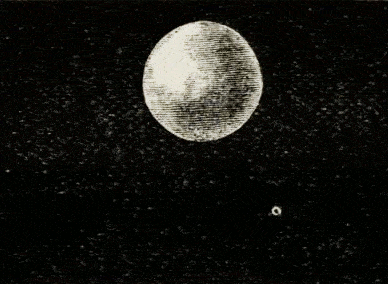
The Splash of a Drop (1895)
The transcript of a “Discourse” given at the Royal Institution of Great Britain in 1894, this short text is a delightful study of the physics and aesthetics of splashing drops — phenomena familiar to “any drinker of afternoon tea”. Crediting a “school-boy at Rugby” with making the initial observation “some twenty years ago”, A. M. Worthington describes how fallen drops of mercury, alcohol, and water may appear to be “lying unbroken” but have actually taken part in “violent exercise”, the traces of which can be glimpsed on opaque glass. Examining these traces, which he calls “footprints of the dance”, leads the scientist to wonderfully minute ends:
The splash of a drop is a transaction which is accomplished in the twinkling of an eye, and it may seem to some that a man who proposes to discourse on the matter for an hour must have lost all sense of proportion. If that opinion exists, I hope this evening to be able to remove it, and to convince you that we have to deal with an exquisitely regulated phenomenon, and one which very happily illustrates some of the fundamental properties of fluids.
The main draw of the book is undoubtedly the mesmerizing series of images — many of which are engravings of photographs — depicting drops at different stages of dissolution. For this, Worthington thanks “the inventors of the sensitive plates”, which have afforded him and his collaborator R. S. Cole “the first really detailed objective views that have been obtained with anything approaching so short an exposure”. For those who are technologically unequipped, he details a lensless process for capturing drops. Before turning to photography, Worthington made use of physiological afterimages. He fabricated a short-duration flashing device and worked in darkness, allowing him to essentially “freeze” the liquid “long enough on the eye for the observer to be able to attend to it”. He would repeat this process until the drawing was complete, and then begin another illustration some .001 seconds later in the drop’s descent.
Along with its captivating images, The Splash of a Drop is also notable for illuminating, descriptive prose. During his research, which he calls a “Natural History of Splashes”, Worthington discovers: that drops have dynamic bodies, which morph into a “beautiful beaded annular edge” during collision; how a drop of milk “rides triumphant on the top of the emergent column”; and that this column then “falls back into the middle of a circle of satellites”. These spouting eruptions are now called “Worthington jets” in their researcher’s honor.
The Splash of a Drop ends with Worthington not trusting his own eyes. Looking over old drawings of drops, he finds discrepancies with his photographs, which he explains as the imagination’s desire for perfection: “the mind of the observer is filled with an ideal splash—an “Auto-Splash”—whose perfection may never be actually realized.” Absolute darkness, he writes, “and other conditions necessary for photography are not very favourable for direct vision.”
R. S. Cole’s elaboration of the photographic process, in an 1894 letter to Nature — which picks up where Worthington left off, “through want of time”, during his discourse at the Royal Institution — is available on archive.org.
Oct 6, 2016







